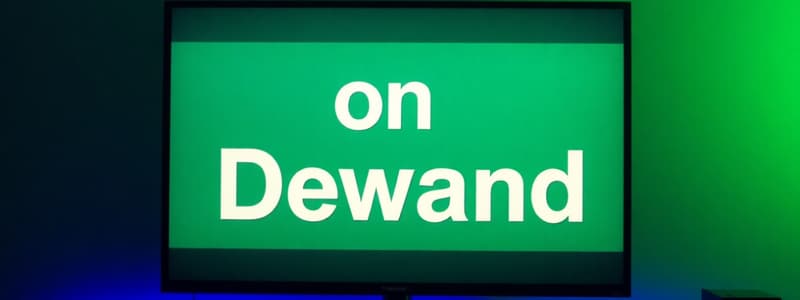Podcast
Questions and Answers
What percentage of YouTube views come from the most popular 20% of videos?
What percentage of YouTube views come from the most popular 20% of videos?
- 97% (correct)
- 70%
- 85%
- 50%
Which type of video content is YouTube known for providing?
Which type of video content is YouTube known for providing?
- Serialized television dramas
- Live sports broadcasts
- Short clips and music videos (correct)
- Long-form documentaries
In terms of device usage, which type of service do consumers generally prefer for watching traditional television programs?
In terms of device usage, which type of service do consumers generally prefer for watching traditional television programs?
- Large television screens (correct)
- Laptops
- Virtual reality headsets
- Mobile devices
What is a key difference between linear TV and VoD services?
What is a key difference between linear TV and VoD services?
What has increased options for consumers to watch audiovisual content?
What has increased options for consumers to watch audiovisual content?
What has the trend of professionalization among YouTube content creators led to?
What has the trend of professionalization among YouTube content creators led to?
What is a potential effect of video-on-demand services on traditional TV?
What is a potential effect of video-on-demand services on traditional TV?
Why might competition between YouTube and traditional TV be considered limited?
Why might competition between YouTube and traditional TV be considered limited?
Flashcards are hidden until you start studying
Study Notes
What is driving the tension between Television and Video-on-Demand services?
- Video-on-Demand (VoD) services, such as Netflix, YouTube, and Amazon Prime Video, are increasingly challenging the traditional model of television broadcasting.
- This competition is influenced by a range of factors, including content differences, consumption patterns, and the economics of attention.
- Content differences often refer to the nature, length, and exclusivity of the content offered.
- Consumers often use different types of services for different reasons, such as watching short videos on YouTube while waiting for a bus but choosing Netflix for a movie night.
- The economics of attention highlights the scarcity of users' time and their need to choose which content they consume. This fosters competition between all services.
- As VoD services evolve, they are increasingly adopting aspects of traditional television, such as linear scheduling with the help of algorithms, and integrating social networking features to enhance user engagement.
Content Differences
- YouTube was initially a platform for user-generated content, but professional content from business companies now accounts for a significant proportion of views.
- YouTube, Netflix, and Amazon Prime Video compete for viewers with exclusive and original content, a strategy often used by television networks.
- The difference in average video length between YouTube and traditional TV and PVoD services is decreasing.
Consumption Patterns
- YouTube caters to shorter viewing sessions due to its focus on short clips, music videos, and social media content.
- Traditional television and PVoD services, like Netflix, are predominantly consumed for longer viewing sessions, such as movies, series, and shows.
- While YouTube is associated with mobile device usage, PVoD services like Netflix are typically consumed on larger screens.
- The lines between different platforms are blurring because consumers can download and watch shows from various services (AVoD, PVoD, and TV) on their mobile devices.
The Economics of Attention
- The economics of attention emphasizes that content providers compete for a finite resource – users' attention. Given that individuals have limited free time, competition for their attention is significant.
- Traditional television and PVoD services, like Netflix, are often used for entertainment purposes, creating direct competition for viewers.
- Netflix's subscription model can be viewed as a replacement for traditional cable television, offering the benefits of non-linear access and customized programming choices.
- The convenience and accessibility of streaming services may contribute to the decline of linear television among younger demographics.
- While choice is a benefit for consumers, some may prefer the simplicity of linear television, especially those who prefer low-involvement consumption in situations like relaxing before bed.
- Traditional television still possesses potential advantages, such as the feeling of social connection through shared viewing experiences. Its bundle of information and entertainment, such as news and prime-time movies, can be more convenient than finding and compiling such content on PVoD and AVoD platforms.
- Algorithm-based recommendation systems, as found on Netflix and YouTube, can offer personalized suggestions and automate content selection, potentially replacing the linear schedule for low-involvement consumption.
Television Viewing Habits
- Traditional television is still the primary mode of content consumption in Germany, with an average daily viewing time between 2018 and 2019, according to Statista.
- In the United States, Netflix is the most popular platform for television content.
- Television drama is increasingly being consumed online, in a non-linear fashion, challenging traditional viewing habits.
- Live streaming platforms, like Twitch, have gained popularity and are challenging traditional ideas about television viewing.
- The popularity of online streaming services like Twitch and YouTube is contributing to the decline of cable television.
Television Industry Changes
- The television industry is undergoing significant transformation due to the rise of online streaming services.
- Media companies like RTL Group, formerly dominant in traditional television, are investing in streaming services to adapt to changing consumer habits.
- YouTube is expanding its premium service featuring ad-free viewing, original content, and background playback.
- The television industry is seeing an increase in vertical and horizontal mergers, suggesting a consolidation of power, potentially leading to less diversity in content.
Theoretical Framework
- The increasing dominance of streaming services can be examined through the lens of “rational choice vs. program-based behavior.”
- The study of media consumption trends can be approached using “seemingly unrelated regression equations,” a statistical method employed to analyze complex relationships between variables.
Studying That Suits You
Use AI to generate personalized quizzes and flashcards to suit your learning preferences.




